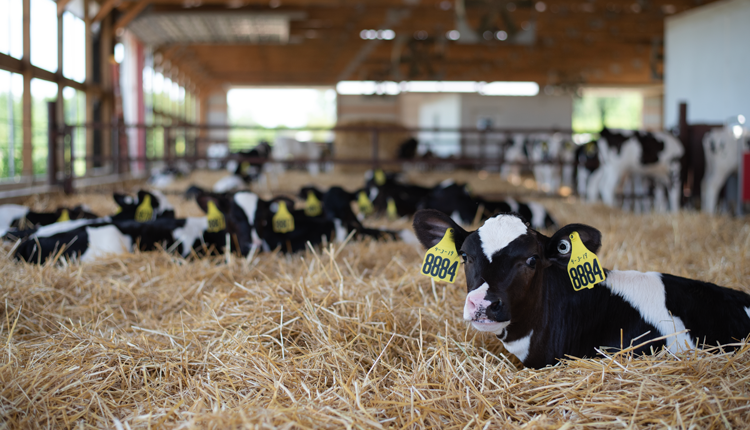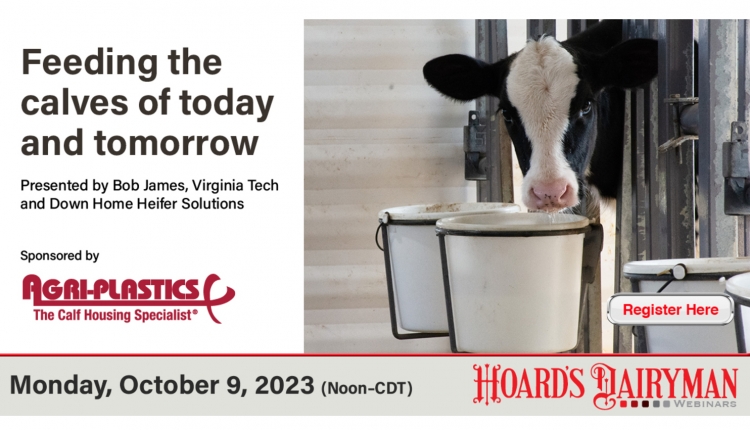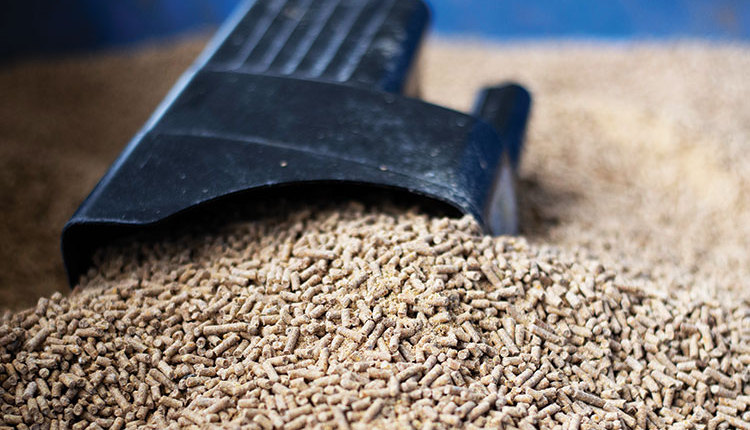The author is the principal in Andhil, LLC, a St. Louis-based consulting firm.
What makes a good calf starter has been discussed in the past. Several aspects of calf starters were addressed, including protein level, impact of fat level in milk replacer on starter intake, and water intake relationship to starter intake. But those are not the only issues. Let's look at several others.
Physical form of starters has impact in several ways. Ground, dusty starters are not eaten well by calves and do little to help develop the rumen. A study done at Cornell by John Porter and Professor Dick Warner, at the time I was a graduate student there, looked at fiber level (low versus high) and coarseness (pellet versus mash) of starters. Calves were purchased, started the trial at equal body weights, and were fed a low level of milk replacer to wean at 28 days of age.
Mash or pellet?

As shown in Table 1, daily gains and starter intakes were low before weaning, typical of this type of program. But notice a pattern developing that high fiber did better than low fiber, and mash (coarse) did better than pellet. These differences were greater after weaning, and the biggest difference was with mash versus pellet.
Why? Because the coarseness and particle size had a greater effect on stimulating rumen development than fiber itself. This also was observed in some calves sacrificed for measurement of rumen pH, papillae development, and volatile fatty acids (VFA). This higher level of VFA especially is critical for butyric which was affected most and is the VFA most responsible for rumen papillae development. Also, in the table, note the same pattern that existed for daily gain and intake also existed for age at first ruminating and percent of time ruminating. They both were greater for mash versus pellet than high fiber compared to low fiber.
As rumen development was stimulated by more advantageous starter formulation and physical form, intake went up which furthered rumen development and added to daily gain. So starters need some physical particle size for proper calf rumen development. And remember that calves do not like to eat dusty, finely ground starters. Besides, they do not facilitate rumen development either.
Keep starter fresh . . .
Additionally, there are some very practical observations that I have made of starter issues. Keep starter fresh, and store it in a dry, covered area to limit the elements and access by birds and rodents. Feed small amounts to youngest calves, and offer more as their appetites pick up.
Always make clean water available, and ensure that water and starter containers are separate so that calves do not dribble back and forth. (See article, "Even in winter calves really need water," January 10, 2006, issue, page 18.) If water and starter containers are not separated, calves will end up with wet starter and dirty water. This will hurt their intake of both and, consequently, their performance.
Keep in mind that there is a simple ratio that calves need to drink about 4 pounds of water for every pound of starter that they will consume.
The key to weaning . . .
Starter intake is the key to good weaning transition, the period of two weeks before and two weeks after weaning. The level of starter intake is affected by the amount of milk or milk replacer fed and their fat levels. There is a substitution effect. The more milk or milk replacer with a higher fat level that is fed, the less starter calves will eat.
The most common problem that I see in this regard is that calves are not eating enough starter during both the pre- and postweaning transition periods. If starter intake is not adequate, there will be a slump after weaning, and calves actually may lose weight. In those cases, you end up "buying back" preweaning gains.
Beyond weight loss, the stress of this major change, in conjunction with other changes at the same time, makes for greater incidence of respiratory problems. Epidemiological studies have shown those problems impair calves for life. This may be due not only to inadequate starter intake before weaning but also to moving calves right after weaning into a group where there is a further, significant feeding change.
To avoid problems . . .
The best way to minimize problems is to keep calves in separate hutches or stalls for another two full weeks after weaning. And use the same starter in the first grouping along with about 10 percent alfalfa hay or silage. Can't afford to do that? Do you know the degree of problems calves are having now, and can you afford that - which you currently pay for whether you realize it or not?

Table 2 centered on when you wean, provides guidelines for starter intake during the weaning transition period. In most cases, I would recommend weaning at 6 weeks of age, rather than the more common 8 weeks. And I would keep calves in the hutches for another two weeks as noted above. This then will not likely require more hutches or stalls if you are currently weaning at 8 weeks of age. And these calves will do better when grouped. They will have greater starter intakes, more rumen development, and be better able to utilize their first feeding of forage.
Your goal should be . . .
The perspective to maintain on a calf starter is that it is the major nutritional variable after the milk or milk replacer source you are feeding. But remember to always provide water, and make sure that containers are separated and that the water is clean. As you feed more milk or milk replacer, and the higher their fat content is, the more limiting effect that will have on starter intake. It is critical to have adequate particle size in the calf starter for rumen development.
When starter intake is too low going into weaning, calves will not be able to avoid a slump after weaning. This is due not only to lower nutrient intake, but also to not having greater rumen development due to the low intake. Whether the particle size is optimal for development of rumen papillae also is an issue.
If calves are moved into a group too soon, less than two weeks after weaning, intake will continue to suffer. This will further limit the ability of the calves to utilize what should be their first exposure to forage. Higher quality forage especially is crucial at this stage. This change, coupled with other significant changes at the same time, greatly adds to the risk that calves will have a respiratory problem which will then likely impair them for life.
Managing this critical process is essential for building on what should be a live, healthy calf at this point. Otherwise, calves may stall out, or even go backwards, limiting their progress then and in the future.
What makes a good calf starter has been discussed in the past. Several aspects of calf starters were addressed, including protein level, impact of fat level in milk replacer on starter intake, and water intake relationship to starter intake. But those are not the only issues. Let's look at several others.
Physical form of starters has impact in several ways. Ground, dusty starters are not eaten well by calves and do little to help develop the rumen. A study done at Cornell by John Porter and Professor Dick Warner, at the time I was a graduate student there, looked at fiber level (low versus high) and coarseness (pellet versus mash) of starters. Calves were purchased, started the trial at equal body weights, and were fed a low level of milk replacer to wean at 28 days of age.
Mash or pellet?

As shown in Table 1, daily gains and starter intakes were low before weaning, typical of this type of program. But notice a pattern developing that high fiber did better than low fiber, and mash (coarse) did better than pellet. These differences were greater after weaning, and the biggest difference was with mash versus pellet.
Why? Because the coarseness and particle size had a greater effect on stimulating rumen development than fiber itself. This also was observed in some calves sacrificed for measurement of rumen pH, papillae development, and volatile fatty acids (VFA). This higher level of VFA especially is critical for butyric which was affected most and is the VFA most responsible for rumen papillae development. Also, in the table, note the same pattern that existed for daily gain and intake also existed for age at first ruminating and percent of time ruminating. They both were greater for mash versus pellet than high fiber compared to low fiber.
As rumen development was stimulated by more advantageous starter formulation and physical form, intake went up which furthered rumen development and added to daily gain. So starters need some physical particle size for proper calf rumen development. And remember that calves do not like to eat dusty, finely ground starters. Besides, they do not facilitate rumen development either.
Keep starter fresh . . .
Additionally, there are some very practical observations that I have made of starter issues. Keep starter fresh, and store it in a dry, covered area to limit the elements and access by birds and rodents. Feed small amounts to youngest calves, and offer more as their appetites pick up.
Always make clean water available, and ensure that water and starter containers are separate so that calves do not dribble back and forth. (See article, "Even in winter calves really need water," January 10, 2006, issue, page 18.) If water and starter containers are not separated, calves will end up with wet starter and dirty water. This will hurt their intake of both and, consequently, their performance.
Keep in mind that there is a simple ratio that calves need to drink about 4 pounds of water for every pound of starter that they will consume.
The key to weaning . . .
Starter intake is the key to good weaning transition, the period of two weeks before and two weeks after weaning. The level of starter intake is affected by the amount of milk or milk replacer fed and their fat levels. There is a substitution effect. The more milk or milk replacer with a higher fat level that is fed, the less starter calves will eat.
The most common problem that I see in this regard is that calves are not eating enough starter during both the pre- and postweaning transition periods. If starter intake is not adequate, there will be a slump after weaning, and calves actually may lose weight. In those cases, you end up "buying back" preweaning gains.
Beyond weight loss, the stress of this major change, in conjunction with other changes at the same time, makes for greater incidence of respiratory problems. Epidemiological studies have shown those problems impair calves for life. This may be due not only to inadequate starter intake before weaning but also to moving calves right after weaning into a group where there is a further, significant feeding change.
To avoid problems . . .
The best way to minimize problems is to keep calves in separate hutches or stalls for another two full weeks after weaning. And use the same starter in the first grouping along with about 10 percent alfalfa hay or silage. Can't afford to do that? Do you know the degree of problems calves are having now, and can you afford that - which you currently pay for whether you realize it or not?

Table 2 centered on when you wean, provides guidelines for starter intake during the weaning transition period. In most cases, I would recommend weaning at 6 weeks of age, rather than the more common 8 weeks. And I would keep calves in the hutches for another two weeks as noted above. This then will not likely require more hutches or stalls if you are currently weaning at 8 weeks of age. And these calves will do better when grouped. They will have greater starter intakes, more rumen development, and be better able to utilize their first feeding of forage.
Your goal should be . . .
The perspective to maintain on a calf starter is that it is the major nutritional variable after the milk or milk replacer source you are feeding. But remember to always provide water, and make sure that containers are separated and that the water is clean. As you feed more milk or milk replacer, and the higher their fat content is, the more limiting effect that will have on starter intake. It is critical to have adequate particle size in the calf starter for rumen development.
When starter intake is too low going into weaning, calves will not be able to avoid a slump after weaning. This is due not only to lower nutrient intake, but also to not having greater rumen development due to the low intake. Whether the particle size is optimal for development of rumen papillae also is an issue.
If calves are moved into a group too soon, less than two weeks after weaning, intake will continue to suffer. This will further limit the ability of the calves to utilize what should be their first exposure to forage. Higher quality forage especially is crucial at this stage. This change, coupled with other significant changes at the same time, greatly adds to the risk that calves will have a respiratory problem which will then likely impair them for life.
Managing this critical process is essential for building on what should be a live, healthy calf at this point. Otherwise, calves may stall out, or even go backwards, limiting their progress then and in the future.









